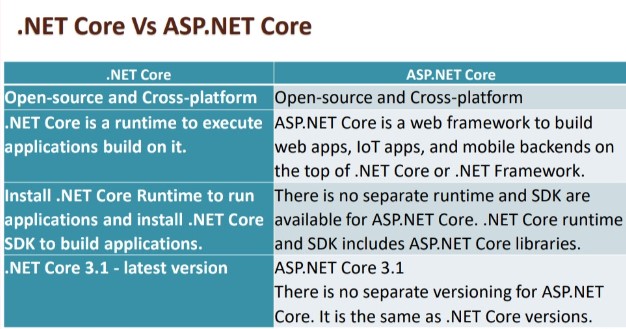Explain ASP.NET Core with its characteristics , difference between .NET Core and ASP.NET Core.
ASP.NET Core
- The new version of the ASP.NET web framework is a free, open-source, and cross-platform framework.
- ASP.NET Core applications can run on Windows, Linux, and Mac.
- So you don't need to build different apps for different platforms using different frameworks.
- It allows you to use and manage modern Ul frameworks such as AngularJS, ReactJS, Umber, Bootstrap, etc. using Bower (a package manager for the web).
ASP.NET Core Characteristics
- It Supports Multiple Platforms
- Hosting: ASP.NET Core web application can be hosted on multiple platforms with any web server such as IIS, Apache, etc.
- It is not dependent only on IIS as a standard .NET Framework.
- Fast: This reduces the request pipeline and improves performance and scalability.
- loC Container: It includes the built-in loC container for automatic dependency injection which makes it maintainable and testable.
- Integration with Modern UI Frameworks
- Code Sharing: allow to build a class library that can be used with other .NET frameworks such as .NET Framework 4. x or Mono. Thus a single code base can be shared across frameworks.
- Side-by-Side App Versioning: ASP.NET Core runs on .NET Core, which supports the simultaneous running of multiple versions of applications.
- Smaller Deployment Footprint: ASP.NET Core application runs on .NET Core, which is smaller than the full .NET Framework. So, the application which uses only a part of .NET CoreFX will have a smaller deployment size. This reduces the deployment footprint.




Comments
Post a Comment